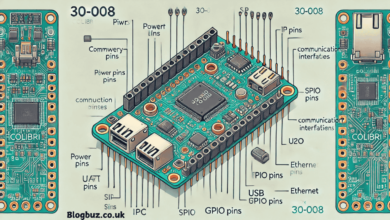How Does SD-WAN Work? Everything You Need to Know About This Network Innovation

Many businesses today face challenges with their networks. Traditional WANs (Wide Area Networks) are often perceived as complex, expensive, and can slow down performance.
As companies grow, move to the cloud, or support remote workers, these old systems no longer meet their needs.
That’s where SD-WAN comes in.
SD-WAN, or Software-Defined Wide Area Network, is transforming the way networks operate. It offers smarter, faster, and cheaper ways to connect offices, cloud services, and remote teams.
In this article, we’ll break down what SD-WAN is, how it works, its parts, and why businesses choose it.
What is SD-WAN?
A Software-Defined Wide Area Network, or SD-WAN in short, utilizes software to manage network connections across different locations. Think of it as putting a smart brain in charge of your network traffic.
Traditional WANs rely on hardware and manual setup. SD-WAN flips this approach by using software to make routing decisions automatically.
Here’s what makes SD-WAN different:
- Software-driven: Policies control traffic flow, not hardware settings
- Flexible: Uses any internet connection – broadband, MPLS, or cellular
- Cost-effective: Reduces dependence on expensive dedicated circuits
SD-WAN is ideal for companies with multiple locations, high cloud usage, or remote workers who require reliable connections.
Core Architecture and Components of SD-WAN
To understand how does SD-WAN work, you need to know its four main components that collaborate together to manage your network traffic.
Edge Devices
Edge devices sit at each company location, including branch offices, data centers, or cloud environments. These devices act as traffic directors for your network.
What they do:
- Route traffic intelligently based on current conditions
- Enforce security policies automatically
- Manage different connection types (broadband, MPLS, LTE)
- Create secure tunnels between locations
Control Plane (Centralized Controller)
The control plane serves as the network’s command center. It makes all the big decisions about where traffic should go.
This centralized controller:
- Manages routing policies across all locations
- Monitors network performance in real-time
- Adjusts traffic paths when problems occur
- Pushes updates to edge devices automatically
Orchestration and Management Plane
The orchestration layer handles the mundane yet crucial tasks that keep networks running smoothly and efficiently.
Key functions include:
- Zero-Touch Provisioning for new devices
- Centralized monitoring and configuration
- Network analytics and reporting
- Policy enforcement across all sites
Data Plane
The data plane performs the actual work of moving packets from one location to another.
It follows instructions from the control plane to:
- Forward packets along the best paths
- Encrypt traffic for security
- Apply quality of service rules
- Handle traffic prioritization
How SD-WAN Works: Step-by-Step Process
SD-WAN creates a smart network overlay that automatically optimizes traffic flow.
Here’s how it works:
Step 1: Tunnel Creation
Edge devices establish encrypted tunnels across all available WAN links. This creates multiple secure paths between locations.
Step 2: Performance Monitoring
The central controller continuously monitors the performance of each link, measuring latency, packet loss, and bandwidth availability.
Step 3: Intelligent Routing
Traffic gets routed based on application needs and current network conditions. Critical applications get priority treatment and the best available paths.
Step 4: Policy Enforcement
The orchestrator ensures all devices follow the same security and performance policies, maintaining consistency across the network.
Step 5: Continuous Optimization
The system continually analyzes performance data and adjusts routing decisions to ensure optimal performance.
Benefits of SD-WAN
SD-WAN delivers measurable improvements in four key areas:
| Benefit | How SD-WAN Helps |
| Performance | Intelligent routing sends traffic over the best available path |
| Security | Built-in encryption and network segmentation protect data |
| Cost | Uses cheaper broadband connections instead of expensive MPLS |
| Management | Centralized control reduces manual configuration work |
Improved Application Performance: SD-WAN identifies different types of traffic and routes them accordingly. Video calls take priority over file downloads, ensuring a smooth user experience.
Enhanced Security: Every connection uses end-to-end encryption. Network segmentation keeps different types of traffic separated, reducing security risks.
Significant Cost Savings: Companies can replace expensive MPLS circuits with more affordable broadband connections while maintaining or even improving performance.
Simplified Management: IT teams manage the entire network from a single central console, eliminating the need to configure each device individually.
Real-World SD-WAN Deployment Models
Companies deploy SD-WAN in three main ways:
- On-Premises SD-WAN
Hardware appliances installed at each location provide maximum control and security. This model is well-suited for companies with dedicated IT staff and stringent security requirements.
- Cloud-Enabled SD-WAN
Virtual edge devices and cloud gateways reduce hardware needs while improving cloud application performance. This approach is suitable for companies migrating applications to the cloud.
- Hybrid Models
Many companies combine on-premises and cloud components based on specific location needs. Critical sites often utilize hardware appliances, whereas smaller locations typically employ virtual devices.
Wrapping Up
SD-WAN revolutionizes business networks.
It separates how data is moved (data plane) from how rules are set (control plane). This makes networks easier to manage, cheaper to run, and faster to respond to change.
If your business wants to modernize its network, keep up with cloud apps, or support remote workers, SD-WAN is worth serious thought.
It’s a smart step toward future-proofing your network setup.




